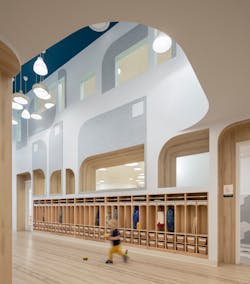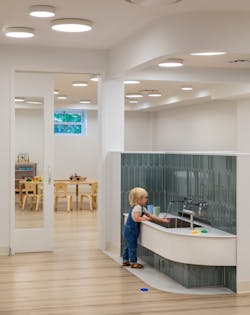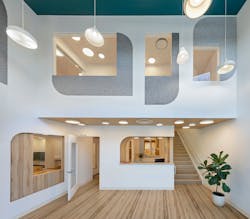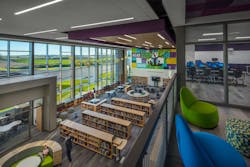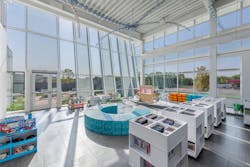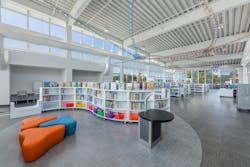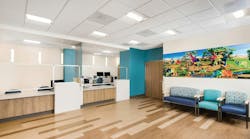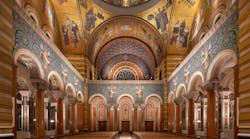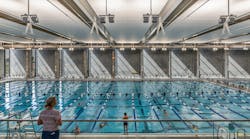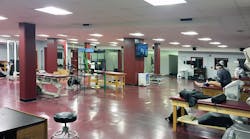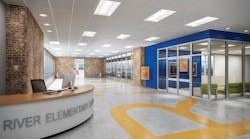Schools today must help capture the increasingly fleeting attention span of students, encourage socialization, inspire curiosity, accommodate the demands of STEM and robotics curriculums, facilitate group learning and more. As classrooms are being created in ways that increase comfort and flexibility, and nurture new learning styles, more thought is also going into the design of the spaces outside the classroom—offering students more places to sit, meet, plan, and collaborate. Lighting is an important consideration in achieving these many, multi-faceted deliverables. The three projects profiled here provide excellent examples of how architects and lighting designers are approaching the new demands of the learning environment with the thoughtful and innovative use of luminaires and light art.
An animated ceiling plane
There is little at first sight of the City Kids Education Center in the Williamsburg section of Brooklyn that reminds the visitor of the traditional “school” setting. The 11,000-sq.-ft. space is more like the lobby and public areas of a charming boutique hotel, with some residential touches. That was the intent of project architect Alexandra Barker, principal of BAAO.
City Kids Education Center offers students, ages 2-12, a smooth transition from home to a creative learning destination. Working with an advisory committee of parents, the need to introduce elements of the out-of-doors became the basis for the interior’s core design factor—a central double-height atrium courtyard. Barker brought the feeling of the sky inside by painting the roof-level atrium covering a rich sky-blue hue. Then she used luminaires in an inventive way to further animate the ceiling plane. From this surface, Barker suspended two dozen fixtures with white shades in variety of organic shapes. During the day, they can represent clouds to the children. On days when it becomes dark in the late afternoon, they can appear as stars to add sparkle to the setting.
Curved niches in the walls accommodate single users or small groups. On the upper level, openings on the perimeter allow children to look down onto the activities in the atrium’s street level.
Constructed during the pandemic, Barker made some COVID-related tweaks to the design of this educational space. “The pandemic prompted some ventilation improvements in the form of electronic and ultraviolet light, HVAC filters, touchless security and check in points, as well as the addition of operable windows to bring light and air to all classrooms,” she said.
Navigate a new school
According to CEO Rich Tennessen of Eppstein Uhen Architects, the building and design decisions, including the lighting, were made to emulate the surrounding farms and agricultural setting. Repetitious patterns are found throughout the building, similar to the rows of crops found in the nearby fields. “Natural daylight and integrated ceiling light were important to give an organic feel to the linear space,” Tennessen said.
Just take a look at how the lighting was designed in the library. Linear luminaires provide the lion’s share of the overhead ambient illumination, but the orientation of the lighting fixtures is not uniform across the ceiling plane. Instead, some of the fixtures run perpendicular to the large window wall in the room, while others, installed on a dropped, dark-toned ceiling surface above the free-standing book shelves, run parallel. Above the informal reading and conversation space adjacent to the window wall are ceiling hung fixtures with filigree green shades that differentiate the space from its neighboring areas.
One of the ways the design of this school differs from the typical single classroom approach is its organization into villages. “It’s a large school, but there are small schools within the school. They’re called villages,” explains Chris Michaud, senior design architect, Eppstein Uhen Architects.
Sustainability was another aspect of the design that was important to the community. Rooftop solar panels generate power, while high-performance glass minimizes heat gain and glare. Geothermal heating contributes to energy savings. Beyond these energy-savvy systems, the school has an online tool that tracks the energy footprint of the building and students and faculty are able to view it.
Tennessen is pleased with student reception of the online tool that gauges the pace of the power being generated and used for the building’s mechanical and electrical functions, including the lighting. “They can see for themselves the amount of power being generated and become familiar with the efficiency of its operations,” he said.
Engaging young minds with light art
The answer: full-height windows that flood the interior with an abundance of natural light; kid-height library stacks that are right-sized for pint-sized exploration, and colorful, upholstered seating large enough for families to read together. While each of these amenities is noteworthy, to admire the most prized feature in the space, one needs to look up to the interactive light art installation titled “Only Connect.”
Produced by award-winning artist Creative Machines, under the direction of Joseph O’Donnell, the Reby Cary Youth Library art installation “represents the vast network of neurons connecting the youth and neighbors of the surrounding community,” said O’Donnell. Measuring over 121 ft.-long and 35 ft.-wide, the work interweaves 20,000 glass spheres. “The internal structure is comprised of a series of welded hubs, interconnected by sweeping arcs of rolled stainless tubing,” said Creative Machines design engineer Brandon Toland. “Intricately wrapped stainless steel ‘lace’ covers the entirety of the sculpture, holding thousands of individually hand-placed glass spheres. Each globe glows from the LED behind it.”
Driving the network of LEDs is a sensor housed in a kiosk that responds to motion and color signals such as people waving their hands, or holding illustrations from children’s books, or the color of visitors’ clothing. There are hidden sensors placed throughout the library that also trigger special lighting sequences. Color Kinetics supplied the LEDs and other components.
“The process of learning and forming mental connections is more easily accomplished in an environment that is beautiful, immersive, and enveloping,” said O’Donnell.
This article appeared in the May 2022 issue of Architectural SSL magazine.

